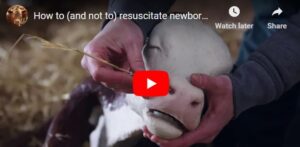Get ‘em out, get ‘em up, get ‘em fed, write ‘em down… Rawhide!

A version of this article, written by Dr. Reynold Bergen, BCRC Science Director, originally appeared in the January 2021 issue of Canadian Cattlemen magazine and is reprinted on the BCRC Blog with permission of the publisher.
It’s called calving difficulty for a reason. They’re difficult to deliver, it’s difficult for the calf to survive, it’s difficult to watch it die, and it’s difficult to lose the $1,250 the calf could have sold for in fall. The Beef Cattle Research Council’s 2019 Adoption Rates of Recommended Practices by Cow-Calf Operators in Canada report indicated that around half of all preweaning death losses occur within 24 hours after birth, with a significant proportion of those attributed to calving difficulties. How you help a calf in the first few hours after a difficult birth is critical to determining whether it will survive to weaning or not.
It’s well known that providing timely calving assistance, effective calf resuscitation and colostrum are critical. But how you do these things is just as important as what you do. These calves have already been through a lot – providing the wrong kind of help can make it harder for them to survive. Sometimes doing the wrong thing is also harder for you.
In 2019, a research team led by Jennifer Pearson and Claire Windeyer of the University of Calgary’s Faculty of Veterinary Medicine studied Benchmarking Calving Management Practices on Western Canada Cow-Calf Operations. The report highlighted a few tweaks to common calving management practices that could significantly improve the survival of calves from difficult births.
What They Did:
Producers participating in the Western Canadian Cow-Calf Surveillance Network were surveyed about how they managed pregnant cows and heifers throughout calving. The survey included specific questions about how quickly producers intervened to assist calving, how they resuscitated calves after assisted births, colostrum management and record keeping practices.
What They Learned:
Half of the 97 producers that responded to the survey were from Alberta, with 30% from Saskatchewan and 20% from Manitoba. The most common herd size was 226 breeding females and ranged from 37 to 2,615.
Get ‘em out: At least one heifer or cow needed calving assistance on over 90% of operations. Overall, 4.9% of females (3.2% of cows and 13.5% of heifers) required calving assistance. This is a considerable improvement over the 12.2% reported by Dr. Cheryl Waldner in an earlier, larger Western Canadian study conducted in 2002.Get ‘em up: Over 90% of producers prefer to resuscitate calves by rubbing them vigorously or poking the nasal septum with straw. Those are both very good things to do. Alarmingly, 50% of producers considered hanging a calf upside down to be an effective option to help resuscitate it. Don’t do that. It makes things worse. When a calf is hung upside-down, the fluid that comes out is from the stomach, not the lungs. In fact, if you hang a calf upside-down, its guts press down on its lungs and make it harder to breathe. Why hurt your back to suffocate the calf?
Get ‘em fed: Ninety-seven per cent of producers checked to see if calves had received colostrum, by observing the calf nursing, observing whether the dam had been nursed, or whether the calf looked full. When supplemental colostrum was needed, nearly 70% used colostrum from cows in their own herd (ideal). Commercial colostrum replacers (also helpful) were less popular. Fewer than 10% of producers sometimes used colostrum obtained from a dairy. Don’t do that. Dairy colostrum is dilute and doesn’t contain enough antibodies to protect the calf. Dairy colostrum can also contain costly diseases you don’t want (e.g. Johne’s disease). It’s important to note that commercial colostrum “supplements” are less concentrated than “replacers.” When producers are using powdered products, read the label to determine how many packages are needed to meet the recommended 100 to 200 grams of immunoglobulin G (IgG) required by a newborn calf.
Write ‘em down: Calving records commonly included birth date (95%), calf identification (90%), and calving ease (74%). Aggressive behavior, udder conformation and mis-mothering were rarely recorded, but were among the most frequent reasons for culling. Records are much more reliable than your memory, especially with large herds. More complete calving records will help you cull the right cows and select the right replacement heifers in fall.
So What … Does This Mean to Me?
The first few hours of a calf’s life had a big impact on whether it survived to weaning and sold for $1,250 last fall. Calves that experience a difficult birth are more likely to get sick and die before weaning. Whether they’re assisted or not, calves that experience a difficult birth are slower to get up, slower to nurse, may consume less colostrum, and have a harder time absorbing the antibodies. Properly resuscitating a calf can help it get going faster, but please don’t make things worse by hanging it upside down. Save your back and give it a rubdown instead. Colostrum replacers can be good insurance, but don’t use dairy colostrum. Write problems down when you observe them, before you forget, and use those records to make better decisions in fall. There are no one-size fits-all solutions to guarantee a successful calving season. But some ‘solutions’ never work.
Your vet can provide additional practical advice and suggestions for saving calves. And if you’re subscribed to the BCRC Blog, you’ll get practical calving season tips in your inbox this week, including a video that demonstrates recommended resuscitation techniques.
The Beef Cattle Research Council is funded by the Canadian Beef Cattle Check-Off. The BCRC partners with Agriculture and Agri-Food Canada, provincial beef industry groups and governments to advance research and technology transfer supporting the Canadian beef industry’s vision to be recognized as a preferred supplier of healthy, high quality beef, cattle and genetics.
References
Pearson J.M., Pajor, E.A., Caulkett, N.A., Levy, M., Campbell, J.R., and Windeyer, M.C. (2019). Benchmarking calving management practices on western Canada cow-calf operations. Translational Animal Science. Volume 3 (4) pages 1446-1459.
Click here to subscribe to the BCRC Blog and receive email notifications when new content is posted.
The sharing or reprinting of BCRC Blog articles is typically welcome and encouraged, however this article requires permission of the original publisher.
We welcome your questions, comments and suggestions. Contact us directly or generate public discussion by posting your thoughts below.
